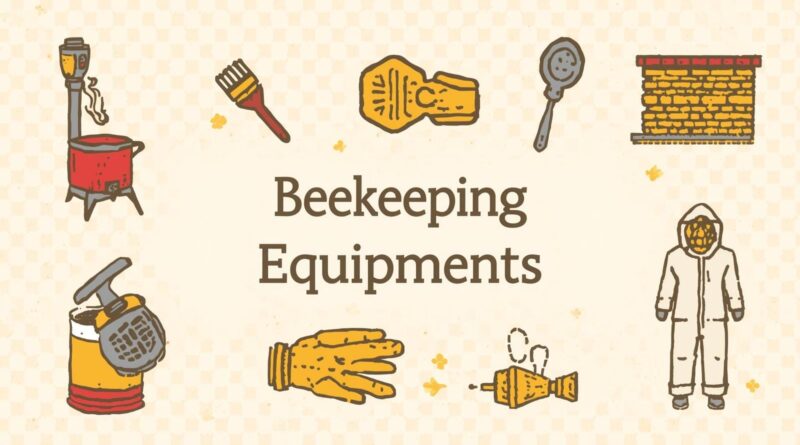Modern Beekeeping Methods and Equipment
Title: Study of Various Beekeeping Equipment
Beekeeping, also called apiculture, is the scientific and organized method of rearing honey bees for valuable products like pure honey and beeswax. In earlier times, Indian beekeepers used crude and unplanned methods that often harmed bees and reduced production. However, after the establishment of the Central Bee Research and Training Institute (CBRTI) in Pune, people started learning modern, efficient, and sustainable methods of beekeeping.
Today, modern beekeeping uses specially designed equipment that helps both bees and beekeepers work safely and productively. Let’s explore these modern methods and tools step by step in a simple and friendly way!
The Frame Hive Method – The Heart of Modern Beekeeping
Modern beekeepers mostly use the frame hive method, which allows bees to build their combs on removable wooden frames inside a hive box. In India, two common types are used- the Langstroth 10-frame hive and the Newton frame hive.
A modern bee box or hive includes several important parts: a stand, bottom board, brood chamber, frames, queen excluder, supers, inner cover, and top cover. Each part has a special purpose, and together, they make honey production smooth, safe, and efficient.

1. Hive Stand and Bottom Board
To begin with, the hive stand is a four-legged structure about 6–9 inches high. It supports the hive and keeps it above ground, which helps drain rainwater and prevents ants or insects from entering.
Next comes the bottom board, which forms the base of the hive. It usually has two gates at the front for bees to fly in and out. This board provides a strong foundation for the entire bee box. The stand supports the hive and prevents the entry of ants and insects. The stand holds the bottom board, which forms the proper base of the hive. It contains two gates in the front position. Beekeepers construct it from a 22″ × 16¼” × 7/8″ wooden board or by joining two wooden boards with rods.
2. Brood Chamber – The Home of the Queen
Above the bottom board sits the brood chamber, which is the most important part of the hive. This is where the queen bee lays her eggs and where new bees are raised. The bottom board supports the brood chamber, the most important part of the hive. Beekeepers prepare it from 7/8″ thick wood in rectangular form without a top or bottom. The chamber measures 20″ × 16½” × 9½” externally and accommodates 10 frames.
Made of strong wood, this rectangular box can hold around ten frames. Each frame is removable, making it easier for beekeepers to check the colony’s health without disturbing the bees too much.
3. Hive Frames – The Building Blocks of the Hive
Each frame is made of wood and has three main parts: a top bar, side bars, and a bottom bar. The Langstroth frames are widely used because they allow easy handling during inspections or honey extraction.
There are two main types of frames:
- Hoffman Frame (Self-spacing Type): It has built-in shoulders that automatically maintain equal distance between frames.
i) The top bar – It is 19″ long, 1″ wide, and 7/8″ thick. The ends of the top bar extend beyond to rest on the rabbet scooped on the long sides of the brood box, and the under surface is grooved for fixing the edge of the comb foundation sheet.
ii) Side bar – It is 9 – 1/8″ long and made from 3/8″ thick wood. Each is cut out from the middle portion at either end to accommodate the top and bottom bars, respectively. There are four holes in each side bar for wiring the frame.

- Staple Spacing Frame: Instead of wooden shoulders, it uses metal spacers at both ends of the top bar to keep uniform gaps. Because of these spacers, bees can move easily, build even combs, and avoid getting crushed when the beekeeper checks the hive.
i) Top bar – Top bar is 19″ long, 1″ wide & 7/8″ thick. It has a groove as like Hoffman top bar. It is covered with metal spacing devices on both ends, opposite faces.
ii) Side bar – Each is made of 3/8″ thick wood.
iii) Bottom bar – It is 16-718″ long, 1″ wide & 3/8″ thick.

4. The Super – The Honey Storage Box
Above the brood chamber is the super, also called the honey super. This box is slightly smaller and is used only for storing honey. It holds several frames filled with wax foundation sheets where worker bees deposit nectar.
When one super gets full, beekeepers simply add another on top a process called supering. This allows bees to store more honey without overcrowding the hive, making large-scale honey collection easier and cleaner.
5. Inner Cover and Top Cover – The Hive’s Protection
The inner cover lies just below the outer lid and helps regulate airflow and temperature inside the hive. It prevents bees from attaching their combs to the top cover and keeps the hive dry. Some inner covers even have small feeding holes so that beekeepers can supply sugar syrup during lean seasons.
The top cover acts as the hive’s roof. It’s usually made of wood with a metal sheet to protect against rain and sunlight. Because it fits snugly, it keeps the hive clean and safe throughout the year, ensuring the colony stays strong and active.
6. Queen Excluder – The Gatekeeper
Placed between the brood chamber and the super, the queen excluder is a thin sheet made of wire, zinc, or plastic. It has small slots that allow worker bees to pass through but block the larger queen bee.
This clever device ensures that no eggs are laid in the honey frames, keeping the honey pure and brood-free. As a result, beekeepers can easily separate the honey section from the brood area during harvesting.
7. Comb Foundation Sheets – Helping Bees Build Faster
Bees naturally spend a lot of energy producing wax for comb building. To save their effort, beekeepers use comb foundation sheets, which are thin sheets of beeswax imprinted with hexagonal patterns.
These ready-made sheets guide bees to build straight and uniform combs quickly. This not only increases honey yield but also keeps the hive neat and easier to manage. Interestingly, the CBRTI in Pune manufactures these foundation sheets using precise molds that match natural bee cell sizes.

8. Honey Extractor – Spinning Honey Safely
Once the combs are full and capped with wax, it’s time to extract honey. For that, beekeepers use a honey extractor, a drum-like machine that works like a washing machine spinner!
Frames are placed inside, and as the drum spins, centrifugal force throws the honey out of the cells without damaging the comb. The honey then collects at the bottom through a honey gate. This process helps beekeepers collect clean, pure honey quickly while allowing bees to reuse the same combs.

9. Uncapping Knife – Opening the Honey Cells
Before extraction, the wax cappings on honey-filled cells must be removed. Beekeepers use an uncapping knife, which is a long, smooth blade that can be gently heated. By gliding it over the frame, they neatly slice off the thin wax layer without damaging the comb structure.
The wax collected from uncapping is later melted and reused to make candles or new foundation sheets nothing goes to waste!

Modern beekeeping is a perfect blend of science, care, and sustainability. With the help of modern equipment like the Langstroth hive, queen excluder, honey extractor, and foundation sheets, beekeepers can collect pure honey efficiently while keeping their bees healthy and happy.
By understanding these methods, students and future apiculturists can truly appreciate how modern beekeeping supports both nature and livelihoods turning a simple wooden hive into a buzzing world of science and sweetness!




